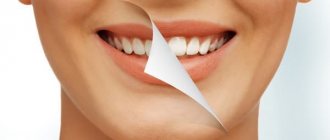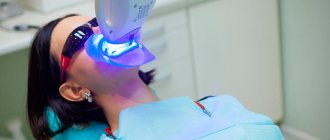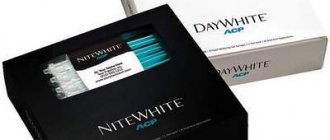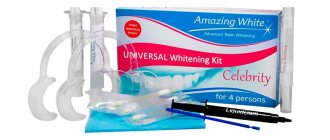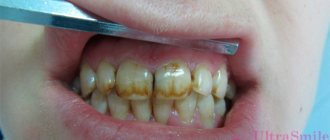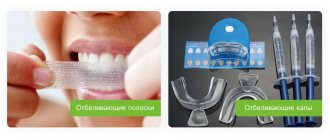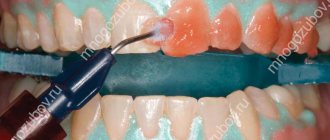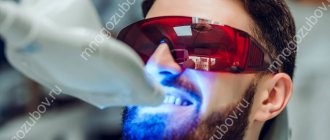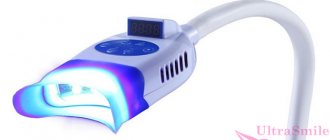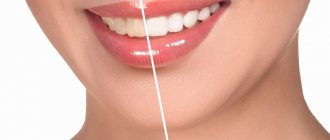From this article you will learn:
- before and after photos,
- teeth whitening Zoom – price 2021.
The article was written by a dentist with more than 19 years of experience.
Teeth whitening ZOOM 4 is one of the professional whitening methods that is carried out in a dental office. The active substance used is 25% hydrogen peroxide gel - in combination with a special “Zoom WhiteSpeed” lamp (Fig. 1-2), which, according to the manufacturer, increases the strength and speed of whitening.
Zoom whitening was developed by the American company DISCUS DENTAL, but LED lamps for it are produced by Philips (the Netherlands). Zoom 4 is already the fourth generation of this system, and before that Zoom, Zoom 2 and Zoom 3 were released in turn. At the moment, only the 3rd and 4th generations of this system are used, which (compared to the previous ones) have become much safer for teeth.
Zoom-4 lamp and whitening kit –
In general, only about 55% of patients have positive reviews of Zoom 4 whitening, and below we will go into detail about the reasons for the negative reviews. For example, the manufacturer’s claimed whitening of teeth by 8 shades in 1 procedure, which lasts for 3-5 years, is more of an advertising ploy. The fact is that the degree of teeth whitening is assessed by the dentist immediately after the whitening procedure, and not a few days later.
But due to exposure to intense light flux, as well as prolonged isolation of teeth from the moist environment of the oral cavity during the procedure, the enamel of the teeth loses moisture, and due to the dryness of the enamel, the teeth initially look much whiter. Within 24 hours, the saturation of the enamel with water will be completely restored, and you will be able to notice that the color of your teeth will no longer be as white as it was immediately after the procedure. But this is not the only problem with the Zoom 3 and 4 systems...
How does Zoom 4 teeth whitening work –
Teeth whitening with the Zoom 4 system is achieved through the simultaneous action of 2 components. The main component of the system is a whitening gel, which contains a 25% concentration of hydrogen peroxide, as well as a special photosensitive activator. The latter accelerates the decomposition of hydrogen peroxide into free radicals when exposed to a light flux of a certain wavelength.
The second component of the Zoom 4 system is the Zoom WhiteSpeed lamp. This is an LED lamp that emits light with a wavelength in the range of 400-505 nanometers. The light flux, acting on the whitening gel applied to the front surface of the teeth, accelerates the decomposition of hydrogen peroxide in it. As a result of this process, free radicals are formed that penetrate the dental tissues, destroying pigment molecules there.
A high 25% concentration of whitening gel + additional exposure to a light source allows you to achieve whitening results of up to 6-8 tones* in just 1 procedure. The duration of the procedure will be only 60 minutes. Whitening stages are carried out three times in a row for 15 minutes, during which new portions of the whitening gel will be applied and the LED lamp will turn on. And at the very end, you will be given an application of remineralizing gel to reduce the adverse effects of whitening on tooth tissue.
Brief and complete video of the Zoom whitening process –
Teeth whitening Zoom 3 and 4: differences
Dental clinics now offer Zoom whitening, which can be performed using either a 3rd or 4th generation LED lamp. Teeth whitening Zoom 3 involves the use of a Zoom Advanced Power lamp (Fig. 5), and teeth whitening Zoom 4 uses a Zoom WhiteSpeed lamp (Fig. 4). The latter has a higher intensity of light flux, as well as the ability to adjust the light intensity during the procedure.
Such characteristics of the WhiteSpeed lamp can reduce the risk of a patient developing pain syndrome (increased sensitivity of teeth), or reduce its intensity. By the way, it should be noted that for Zoom 3 and 4, a whitening gel of the same composition and characteristics is used. Thus, the difference between them lies solely in the functionality of the lamp itself.
Both lamps look almost the same -
Important: an interesting point is that, unlike all other whitening systems, Zoom lamps emit light in the ultraviolet range. The fact is that ultraviolet light itself has a slight bleaching effect. However, other manufacturers of similar whitening systems especially emphasize that their whitening lamps are equipped with a 100% ultraviolet filtration system to avoid negative effects on the oral mucosa (24stoma.ru).
The manufacturer Zoom claims that its lamps have filters that remove all the negative part of the ultraviolet spectrum and produce only safe ultraviolet light. But how true this is and whether this can lead to the development or worsening of diseases of the mucous membrane (for example, leukoplakia) - one can only guess. And therefore, in our opinion, the use of Zoom can be dangerous for smokers, who are already at risk for the development of precancerous diseases of the oral mucosa and the red border of the lips.
LED lamp and its advantages
The main advantage of using LED lamps for teeth whitening is that there is no threat to the patient’s health. This method has passed all tests and is considered one of the safest. The rays that are reproduced by the lamp pass through a special filter, the task of which is to neutralize the harmful effects of infrared waves and ultraviolet radiation. Thus, the enamel surface is exposed to a temperature no higher than 37.6ºC. In addition, other advantages of this procedure can be noted:
- Short time for the whitening procedure.
- The ability to get the desired result the first time.
- The gel used contains components that help reduce sensitivity to the procedure.
- The effectiveness of the system makes it possible to eliminate defects such as age-related darkening and darkening caused by fluorosis.
The disadvantage of the teeth whitening procedure with an LED lamp can be considered the cost of the session, the price of which varies between 7,000 and 20,000 rubles and a large list of contraindications.
Zoom teeth whitening: price
The cost for Zoom teeth whitening in 2021 will be about 15,000 rubles in mid-price clinics. Moreover, the cost will not depend on the generation of the whitening lamp. And in any case, Zoom 3-4 generations will use the same version of the clinical whitening kit, which will contain 25% whitening gel and many different devices.
There are 2 options for sets (Fig. 6). The first option is Zoom CH Single Kit, which is an individual kit for 1 patient; its cost is about 10,000 rubles. The second option is a set for 2 patients, the cost of which will be about 17,000 rubles. Therefore, when they offer you Zoom whitening costing 8,000 rubles, it will probably be a scam. In this case, most likely, whitening gel and consumables from a cheaper manufacturer will be used, or even fake “Zoom” kits from Chinese manufacturers.
The maximum price for Zoom whitening in Moscow reaches 30,000 rubles. When you decide whether to buy this procedure or not, keep in mind that after the procedure in the clinic, you will still have to additionally buy home teeth whitening Zoom (Fig. 7). This set is designed to support results and is available in two versions: Zoom “Nite White” or “Day White”.
These kits contain whitening gel for use at home. Only the purchase price (cost price) of such kits for maintenance therapy will be about 8,500 rubles, but in the clinic you can only buy them with a corresponding additional markup. Therefore, consider what the final price for Zoom whitening will be...
How to save the result
Once you've gotten the whiteness you wanted, don't forget that your teeth now need more careful care. For a week, it is best to follow a clear (white) diet, the essence of which is to exclude coloring or very hot foods. It is also better to reduce your cigarette consumption.
In addition, professional products from the ASEPTA series for oral care will help you. They will prevent the appearance of yellow plaque, caries and other troubles, for example, ASEPTA Sensitive toothpaste will help reduce tooth sensitivity after the procedure. In the future, you can use ASEPTA PLUS Remineralization or Gentle Whitening toothpaste to maintain a snow-white and healthy smile.
Sources:
- Report on determining/confirming the preventive properties of toothpaste “ASEPTA PLUS” GENTLE WHITENING” Author: doctor-researcher A.A. Leontyev, head Department of Preventive Dentistry, Doctor of Medical Sciences, Professor S.B. Ulitovsky First St. Petersburg State Medical University named after. acad. I.P. Pavlova, Department of Preventive Dentistry
- Report on the determination/confirmation of the preventive properties of personal oral hygiene products “ASEPTA PLUS” Remineralization doctor-researcher A.A. Leontyev, head Department of Preventive Dentistry, Doctor of Medical Sciences, Professor S.B. Ulitovsky First St. Petersburg State Medical University named after. acad. I.P. Pavlova, Department of Preventive Dentistry
- Clinical studies of antisensitive toothpaste “Asepta Sensitive” (A.A. Leontyev, O.V. Kalinina, S.B. Ulitovsky) A.A. LEONTIEV, dentist O.V. KALININA, dentist S.B. ULITOVSKY, Doctor of Medical Sciences, Prof. Department of Therapeutic Dentistry, St. Petersburg State Medical University named after. acad. I.P. Pavlova
- Report on determining/confirming the preventive properties of toothpaste “ASEPTA PLUS” COFFEE and TOBACCO Author: doctor-researcher A.A. Leontyev, head Department of Preventive Dentistry, Doctor of Medical Sciences, Professor S.B. Ulitovsky. First St. Petersburg State Medical University named after. acad. I.P. Pavlova, Department of Preventive Dentistry
Advantages of professional whitening Zoom 4 –
The main advantage of professional whitening systems at the dentist is the high speed of achieving results. But, as for the effectiveness of whitening, many modern products for use at home (whitening strips, as well as special home kits consisting of aligners and gel) are no less effective at the moment, but still require significantly longer duration of use.
According to the manufacturer, Zoom 4 whitening has the following advantages (some of which are quite controversial and we will also comment on them below)…
- you only need 1 visit to the dentist,
- whitening up to 8 shades,
- the whitening result lasts for 3-5 years,
- The procedure lasts only 1 hour,
- the concentration of hydrogen peroxide is only 25%, which is 10% lower than in similar professional whitening products from other manufacturers (this reduces the severity of side effects),
- the whitening gel has a pH from 7.5 to 8.5 (does not cause pronounced demineralization of dental tissues),
- The whitening gel contains components that strengthen the enamel and reduce tooth sensitivity.
Below we will show you “before and after” photos of patients, and also tell you why reviews of teeth whitening with the Zoom system (with all the advantages listed above) are only positive for about 55% of patients.
What is considered the coolest whitening equipment today?
Dental hygienists at German Implantology Centers use the most effective equipment to date – ZOOM 4. The photo-whitening system using ZOOM 4 technology not only makes teeth 8 shades lighter, but also destroys pathogenic microbes that cause various diseases of the oral cavity.
Advantages of teeth whitening in dentistry using the ZOOM 4 system:
- tooth sensitivity goes away a few hours after the procedure;
- minimal risk of thermal impact on the pulp;
- maximum duration of the procedure is 45 minutes;
- The most gentle whitening in dentistry with a maximum period of preservation of teeth whiteness - more than five years.
Zoom: before and after photos
Reading reviews of Zoom teeth whitening (which we will also present later in this article) you will see that many patients note a good effect from the procedure only if the teeth were initially quite yellow. In this case, the “before and after” effect of whitening is visible quite well. If you want to make already quite light teeth whiter, the effect will be practically unnoticeable.
Teeth whitening Zoom-4: before and after photos
Dental care after surgery
After teeth have been given dazzling whiteness in the dentist’s office, the patient must follow some rules:
- For the first 7 days after whitening, avoid eating too hot or cold foods, as well as foods with a high acid content.
- After teeth whitening, you should minimize your consumption of coffee, strong black tea and red wine. And it’s better to quit smoking altogether.
- Visit your dentist regularly for professional teeth cleaning and treatment of any problems that arise.
- Use high-quality toothpastes, toothbrushes and flosses for regular hygiene, which will ensure complete removal of food debris and prevent the deposition of plaque, which can significantly worsen the color of the enamel.
Teeth whitening Zoom 4: reviews
As we said at the beginning of the article, only about 55% of patients were satisfied with Zoom whitening for its fast and good results. However, the remaining patients regretted their choice and said that they would never undergo this procedure again and would not be able to recommend it to anyone. Let's figure out what this was connected with (all reviews are unique and taken from the site https://www.realself.com/zoom-teeth-whitening/patient-reviews).
Severe shooting pains in teeth -
Reviews of Zoom whitening from people with hypersensitive teeth usually contain complaints of sharp shooting pains in the teeth, which can occur both during the whitening procedure and for several days after its completion. However, many patients who have never previously suffered from hypersensitivity also report the appearance of severe pain.
Reviews describe many cases where patients had to ask the doctor to interrupt the procedure due to unbearable pain. In this case, the lamp was turned off, and the whitening gel was immediately washed off from the teeth. Patients were prescribed strong analgesics and applications with enamel-strengthening gels. Despite the fact that we present negative reviews below (because this will allow you to understand what you may encounter) - we objectively recognize that 55% of patients were satisfied with Zoom.
Examples of reviews –
- Reviewed January 26, 2021 “Within an hour I began to experience terrible shooting pains that lasted up to 30 seconds each time.
I had to leave my job. By the time I returned home, I had constant pain in all my teeth. I moaned and rolled on the sofa until the evening, and in the evening I went to the dentist's office. The doctor rubbed some kind of anesthetic gel into my teeth and prescribed a strong painkiller. But the pain did not disappear, I did not sleep all night. The pain went away only after 16 hours. Seriously, if your teeth have even the slightest sensitivity - I would not recommend this ever. It was the most painful procedure of my life. My experience may not be everyone's experience, but for me it was terrible. So I wanted to warn people so they don't experience the same thing I did."
- Reviewed June 10, 2021 “Let me start by saying, you can't even imagine the pain that comes with Zoom. Before the procedure, the dentist's exact words were: "you may feel a little sensitivity in 1-2 teeth." This didn't bother me because I don't have sensitive teeth. The first 10 minutes of the procedure went without any worries. But over the next 30 minutes there were terrible stabbing sharp pains in each tooth. It is as if the nerves were exposed to an electrical current. Yes, my teeth are several shades whiter, but I will never repeat this procedure or recommend it to anyone.”
- Reviewed February 18, 2021 “6 hours later I am still in a lot of pain and the painkiller Advil isn't even helping. I can't eat anything, take a sip of water or even talk. This is terrible, I will never do this procedure again. Yes, my teeth look whiter, but it's not worth the pain I'm going through."
- Reviewed October 3, 2021 “The pain started about 10 minutes after the end of the session. At first it was mild, but after a couple of hours I was in bed, drinking a strong painkiller. I can't work because I can't even talk. Air entering through my mouth when I speak causes severe pain. I tried to suck the bread and even that caused pain. I'm so upset, it's killing me! I wouldn't recommend it to anyone! I can imagine how harmful this procedure is for my teeth if they react this way. Save your money and yourself!”
- Review January 30, 2014 “I went for my regular checkup and the dentist said my teeth were perfect for whitening.
I had noticed yellowing of my teeth before, but had never had professional whitening done. They told me that “there would be some tooth sensitivity,” but I was not prepared for the absolute excruciating pain that I experienced already during the procedure, and it only got worse from there. 10 minutes after the start of the procedure, I experienced the first severe shooting pains. By the end of the whole procedure, my eyes were full of tears. The doctor coated my teeth with fluoride and gave me ibuprofen, but none of that worked. I can't eat or even move my mouth because... any touch of the teeth causes excruciating pain in them. I can't stop crying even though I left the clinic two hours ago. My teeth have never been this sensitive, so it's not just my body overreacting. I wish I had used whitening strips or something else. If you think you may have even the slightest tooth sensitivity, the strips will work infinitely better and cause far less pain than the Zoom procedure."
Conclusions: you should not undergo a professional whitening procedure in principle if you periodically experience pain in your teeth due to thermal and mechanical stimuli (i.e., there is increased sensitivity of the teeth). In other cases, the risk of developing acute pain will be significantly lower. Zoom-4 uses the latest generation of WhiteSpeed lamp, which allows during the procedure, if necessary, to reduce the intensity of the light flux, which somewhat reduces the severity of pain.
The degree of whitening may be lower than expected -
As we said above: teeth lightening by 6-8 shades in 1 Zoom procedure is not very true.
The dentist will measure your teeth color using a special scale (for example, Vita or others) - before and immediately after the whitening procedure. The problem is that teeth lose a lot of moisture during whitening, and overdried teeth always look whiter. Therefore, when the dentist shows you the change in tooth color immediately after the procedure, you should know that the resulting tooth color will change within 1-2 days. This will happen because the hard tissues of the teeth, overdried during the procedure, will gradually become saturated with moisture, which will lead to a decrease in the degree of whiteness of the teeth obtained immediately after the Zoom whitening procedure.
Determining the shade of teeth using a special scale -
If your dentist insists on guaranteeing that your teeth will be 6 or 8 shades lighter, then ask him to measure the color of your teeth not immediately after the procedure, but the next day, and ask him to include this clause in the contract for the possibility of a refund. Believe me, the dentist’s mood will immediately change... You can get a fairly good result only if your teeth are really yellow. If your teeth are already quite light, but you want to make them even whiter, keep in mind that the visible effect obtained immediately after the procedure will be practically unnoticeable after 1-2 days.
Examples of reviews –
- Reviewed December 27, 2021 “I had Zoom teeth whitening twice because... the first time my teeth looked no better. My teeth didn't look like the ones in the Zoom commercial. My before and after photos look almost identical (this was after the first time, but even after I did it the second time - the results were about the same). It’s not worth the cost and it’s not worth the pain I’ve endured.”
- Reviewed June 11, 2015 “Unless you have super yellow teeth, you won't notice a significant difference. Unless the whitening doctor only treats half of your teeth so you can compare the difference. Don’t be fooled by doctors who will guarantee you super results, because... They themselves cannot predict what the effect of whitening will be on each individual patient.”
Why the effect may not last long -
Although dentists claim that Zoom teeth whitening can give results for 3-5 years, this is basically advertising again. The problem with quickly lightening teeth in 1 procedure is the high rate of “rebound” of tooth color. And there is a dependence: the shorter the procedure, the faster your natural teeth color returns. That is why with whitening systems, which involve daily procedures for 30-60 minutes for 10-20 days, the achieved effect lasts longer.
And that is why the manufacturer Zoom also produces home whitening systems, the regular periodic use of which is necessary to maintain the result. And immediately after the procedure, the dentist will always recommend that you buy such a home support system Zoom. As a result, the final cost of Zoom whitening will be 5-6 times higher when compared with high-quality home whitening systems such as “Opalescens”.
A 2013 publication by Basson, which reviewed the results of 49 clinical studies conducted from 1998 to 2011, states that professional whitening achieves initial improvement in tooth color—only slightly better than at-home whitening systems. Moreover, when measuring the color of teeth 4 weeks after the end of the whitening procedure, professional whitening showed a significantly greater relapse of tooth color (compared to home whitening).
Examples of reviews –
- Reviewed August 27, 2013 “A few weeks before getting veneers, I had a Zoom teeth whitening treatment as recommended by my dentist. I didn't feel anything during the treatment, but an hour after leaving the clinic I began to experience excruciating pain that lasted for about eight hours. Although my teeth became significantly whiter - this whiteness faded within 1 month. Now more than 4 months have passed since the treatment, and I can hardly see the difference between “before” and now. I will no longer undergo this procedure because I believe that it is not worth the pain and the cost.”
- Review dated April 20, 2014 “The result obtained is not worth a penny. So, the almost invisible effect of Zoom disappeared after 2 days. I had better results even after using regular at-home whitening strips. In general - never again, a waste of money."
Risk of chemical burn to gums –
Before a whitening procedure, your dentist will always place what is called a “liquid rubber dam” on your gums, which is supposed to seal off 25% of the hydrogen peroxide from your gums. Sometimes dentists do not properly isolate the gums and lips from contact with the whitening gel, which leads to the development of a chemical burn. The problem is that scarring of the gums and lowering of its level can occur, exposing the surface of the tooth root.
What does a gum burn look like after Zoom?
Review example –
- Reviewed February 3, 2021 “The day after the procedure, the entire inside of my lower lip was white and very sore. It looks like my entire bottom lip was burned off by the hydrogen peroxide. I can't drink hot drinks, eat anything spicy, or brush my teeth because they all cause severe pain when they touch my lips and gums. Due to the fact that I can’t brush my teeth, they are no longer so white. I wish I had never done this."
Negative effects on tooth tissue –
If they tell you that professional whitening does not lead to demineralization of dental tissues (loss of calcium), then you should not believe it. Clinical studies "Sighiand Denry" (1992), "McCracken et al." (1996) showed that chemical bleaching leads to a decrease in enamel strength and wear resistance to abrasives and chemicals. And the higher the concentration of hydrogen peroxide is used, the higher the degree of demineralization of enamel and dentin.
That is why the manufacturing company Zoom recommends that all patients undergo remineralization therapy not only after the whitening procedure, but also before it begins. In addition, the contraindications to Zoom include a group of patients with weak resistance of tooth enamel to acids and mechanical stress (i.e., patients with weak mineralization of tooth enamel), which once again confirms that whitening has a negative effect on the hard tissues of teeth.
Review example –
- Reviewed October 16, 2014 “I have always had white teeth, but I wanted them to be even whiter. So I did Zoom. It was the worst experience. I have never had tooth decay or gum disease. I had severe pain after the procedure. But the most important thing is different... I began to notice that the enamel began to collapse (peel off) from the front surface of my teeth.”
Commentary on the review - if a dentist recommends a whitening procedure for a patient with weak enamel mineralization, then destruction of its surface layer is indeed possible. To reduce the risk of tooth decay, teeth are treated with “Relief” gel based on amorphous calcium phosphate before and after Zoom. The use of a gel is an attempt to compensate for the negative effects of whitening on tooth tissue, which will certainly reduce the negative effects of exposure to high concentrations of hydrogen peroxide on tooth tissue.
Pay attention to the following before and after photo (Fig. 17). If you look closely, in the first photo taken before the Zoom procedure, there are white chalky spots on the teeth. Such stains indicate insufficient mineralization of tooth enamel, and as a result, poor resistance to chemical and mechanical factors. Because The dentist neglected the rules for selecting patients for this procedure - the patient received not only uneven tooth color, but also a predisposition to the development of caries and increased enamel abrasion.
Increases the risk of fillings falling out –
Clinical studies by Della Bona et al. 1992, Tiunsakeretall 1990, Titleyetall 1991 - showed that chemical bleaching with hydrogen peroxide disrupts the bond between tooth dentin and filling materials (both light composites and glass ionomer cements). As a result, the marginal fit of the filling to the tooth tissue deteriorates, which can lead to the development of caries at the filling/tooth interface and loss of fillings.
Technology
The Zoom whitening procedure is based on the use of gels with a high content of hydrogen peroxide or carbamide peroxide. To activate such a drug, a special lamp is used, the main light spectrum of which is in the ultraviolet zone. Under the influence of light, the gel begins to heat up and release active oxygen ions, which penetrate deep into the dental tissues and destroy coloring pigments. As a result, the enamel acquires a beautiful natural white color.
Is this type of teeth whitening harmful? Subject to all safety rules and procedure technology, the dentist can guarantee the safety of manipulations and harmlessness to tooth enamel. But you can whiten with the Zoom system no more often than once every six months.
Before the whitening procedure, you must undergo a thorough examination by a dentist. If dental or gum disease is detected, it is necessary to undergo treatment and, in some cases, postpone the procedure until complete recovery. It is advisable to have the enamel professionally cleaned of tartar and other deposits within a few days. This will allow the gel to penetrate the tissue more actively and the lightening effect will be more pronounced.
The procedure itself with the preparatory stage takes 1.5-2 hours:
- Before whitening, the doctor determines the initial color of the enamel using the standardized VITA scale and discusses with the patient the shade that will be optimal for him.
- For the safety of the patient, before dental surgery, lips and cheeks are treated with a special cream with protection from ultraviolet radiation and fixed with a special retractor. It is mandatory to wear protective glasses on the patient's eyes to prevent burns.
- A composition is applied to the gums along the contour of the teeth, instantly hardening in air, which prevents the active gel from getting on the delicate mucous membranes.
- The gel is applied directly to the surface of the 10 upper and 10 lower teeth (“smile zone”) in an even, thin layer.
- A Zoom lamp is brought close to the teeth, which is fixedly fixed to a tripod. Its light falls exclusively on the bleached area.
- After 20 minutes, the remaining gel is carefully removed and the drug is applied again. The bleaching procedure is repeated. In total it includes 3 cycles.
- After the procedure is completed, the gel and protective substance are removed. A remineralizing solution is applied to the tooth enamel, which will help the teeth recover and reduce the likelihood of increased sensitivity.
How does light affect the effectiveness of whitening?
Not all, but many professional teeth whitening systems recommend using light during the procedure, and Zoom is no exception. For many years, there has been debate in the dental community about whether light activation actually speeds up and improves the teeth whitening process. So why do we need light here at all?
According to the technology, the light flux activates a chemical photocatalyst in the whitening gel, which helps break down hydrogen peroxide into active components (free radicals). This increases the concentration of active radicals that simultaneously act on tooth tissue, which in theory should increase the strength of whitening. Most scientific publications on this topic are not independent, and are financed by the manufacturers of such systems themselves.
But there are also several independent studies that use the most objective approach to assessing results, called “split arch”. Using this method, each patient's teeth are divided into halves: on the left half of the jaws the same type of whitening is performed with light, and on the right half - without light. Next, the results are compared. This method is the gold standard for evaluating whitening methods because... here different methods are compared on the teeth of one person, and not on different people (whose teeth may respond differently to whitening).
List of scientific studies (showing that the use of light does not affect the effectiveness of whitening) –
- Hein 2003 This study used the split-arch method to evaluate the effectiveness of 3 professional bleach systems (LumaArch, Optilux 500 and Zoom !) - with and without the use of bleach light. Conclusion: Additional use of light did not whiten teeth any better than simply using a whitening gel.
- CRA 2003 This clinical study also used the split arch method to study 7 professional whitening systems - LaserSmile, LumaArch, Niveous, Opalescence Xtra Boost, PolaOffice, Rembrandt and Zoom ! Conclusion: Using the whitening light did not improve the whitening process compared to using only the whitening gel included in the kits for these systems.
- Kugel 2006 Conclusions: A clinical study using the split arch method showed that the results of light-activated whitening were slightly better, but only initially. When the subjects' teeth were re-evaluated 2 weeks after treatment, no differences were found where the whitening light was used and where it was not.
→ Example of a clinical study (about the ineffectiveness of light in teeth whitening).
Then why do dentists recommend light whitening?
It's all about marketing. Using a light lamp during whitening adds a “glamour” to the procedure, making the whitening process more impressive. And this impression of something special tends to attract consumers and help stimulate demand for such a service. In turn, home whitening systems do not offer additional light exposure, although they are no less effective.
Thus, whitening lamps allow you to solve 2 problems at once. Firstly, they motivate patients to choose professional rather than home whitening systems (because in the eyes of patients they look more convincing). Secondly, this allows you to sell a professional whitening service costing from 15,000 to 20,000 rubles - much more expensive than whitening systems for home use, which cost about 3,500-5,000 rubles.
That's the whole secret. In addition, companies producing whitening systems now make money not only from kits with whitening gel, but also from sales of whitening lamps to dental clinics. Therefore, it is natural that manufacturers of foaming mouth whitening systems will claim that their light lamp is an important part of the whitening process. For example, the cost of a Zoom WhiteSpeed lamp will cost a clinic approximately 180,000 rubles, which is naturally passed on to the patients.
The power of a smile
Facts about laughter
- 10-15 minutes of laughter burns the equivalent of a 100g chocolate bar.
- 100 km/h - this is the speed at which air escapes from the lungs when laughing.
- 17 minutes of laughter a day prolongs life by one year.
- Cheerful people are 40% less likely to suffer from heart disease.
- A person uses 17 facial muscles to smile, and 43 to frown.
- The most smiling people live in Brazil and Cuba.
- 69% of men consider women with an open smile attractive, preferably without makeup.
Laughter is the best medicine. Do you think this is just a figurative expression? Not at all. This is a proven fact! Laughter relieves stress and lifts your spirits, and recent research has shown that it can even fight disease.
While all social gestures of acceptance - handshakes, hugs, head nods - have multiple interpretations depending on cultural traditions in different countries, smiling is a universal sign of happiness, interpreted positively in all languages of the world. A snow-white smile is a sign of not only happy people, but also successful people.
Zoom whitening: contraindications
There is a list of absolute and relative contraindications to professional whitening. Absolute contraindications mean “under no circumstances,” and relative contraindications are possible, but only after eliminating the negative factor/situation in the patient’s health condition
1) List of absolute contraindications –
- oncological diseases,
- diabetes,
- age up to 18 years,
- pregnancy and lactation period,
- increased sensitivity to ultraviolet radiation,
- taking certain medications that cause increased tissue sensitivity to ultraviolet radiation (see list of medications below).
Name of drugs by INN (international non-proprietary names): Ciprofloxacin, Chlorthiazide, Chlopthalidone, Demodocylin, Nabumetone, Hydrochlorothiazide, Norfloxacin, Ofloxacin, Naprosyn, Oxaprozin, Sparfloxacin, Piroxicam, Tetracyclin, Psoralens, Sulindac, Doxycydine.
2) List of relative contraindications –
- with inflammation of the gums,
- in the presence of untreated caries,
- in the presence of deep wedge-shaped defects with exposure of dentin,
- if you have fillings, crowns or veneers on your front teeth*
*You should note that chemical whitening only affects the tooth structure, but cannot change the color of crowns, veneers and fillings that may be on the front teeth. Therefore, if you are not going to spend money on replacing fillings and crowns, you should not do whitening, because... you will get a sharp contrast between the whitened tooth tissue and the fillings and crowns of the previous shade.
The difference between ZOOM and laser whitening –
Whitening Zoom involves the use of the following light lamps... The Zoom-3 uses an “Advanced Power” lamp - with a light wave range from 350 to 400 nanometers, and the Zoom-4 uses a “WhiteSpeed” lamp with light waves in the range of 400-505 nanometers. Thus, the lamp emits light waves not of a specific one wavelength, but a whole beam of waves of different lengths.
The latter, by the way, allows us to call Zoom a technique for photo-whitening teeth. In turn, diode lasers used for laser whitening emit only one strictly defined wavelength, for example, 810 nanometers. At the same time, both methods use a similar whitening gel. We hope that our article on the topic: Zoom-4 teeth whitening was useful to you!
Sources:
1. Add. prof.
, 2. Based on personal experience with whitening, 3. National Library of Medicine (USA), 4. American Academy of Cosmetic Dentistry (USA), 5. https://www.realself.com/, 6. https:// www.usa.philips.com/.
Amazing White system – advantages, features, indications
An innovative method of whitening tooth enamel, Amazing White occupies a leading position in the ranking of the best dental techniques aimed at restoring the snow-white color of tooth enamel. The technique is based on the use of a special gel containing an active substance - hydrogen peroxide, which effectively lightens the tooth crown without compromising the integrity of the tissue structure.
